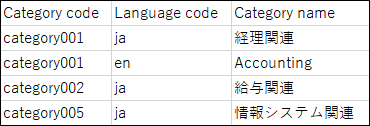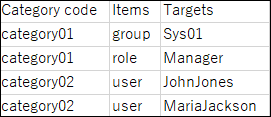Workflow
This section describes the CSV file format for workflow data.
Categories
This section describes the CSV file format used to import categories.
Example Description:

| Item | Number of characters | Required item | Remarks |
|---|---|---|---|
| Parent Category Code | 100 characters | For the category to be placed in the root, specify "ROOT_CATEGORY". If omitted, category is placed in the root. | |
| Category Code | 100 characters | ||
| Category Names | 100 characters | ||
| Memo | 65,535 characters | The maximum number of characters is 65535 with single-byte characters. The maximum number of characters varies depending on the character type. |
Category Names
This section describes the CSV file format used to import category names for each language.
Example Description:

| Item | Number of characters | Required item | Remarks |
|---|---|---|---|
| Category Code | 100 characters | ||
| Language code | Specify one of the following language codes.
|
||
| Category names | 100 characters | Specify category names for each language. |
User Rights
This section describes the CSV file format used to import access permissions.
Access permissions are set for categories. For each category for which you want to set access permissions, describe the lines to set security model and the lines to set access permissions.
- Lines for setting the security model:
Describe the security model for the category. The format is as follows.Category code,Items,Values - Lines for setting access permissions:
Describe access permissions to be set in separate lines for each target. The format is as follows.Category code,Items,Values,Targets
Example:

b): 2nd data
c): Lines for setting up the security model
d): Lines for setting access permissions
| Item | Number of characters | Required item | Remarks |
|---|---|---|---|
| Category Code | 100 characters | ||
| Items | Specify "security_model". | ||
| Available Values | Specify one of the followings.
|
| Item | Number of characters | Required item | Remarks |
|---|---|---|---|
| Category Code | 100 characters | Specify the same category code as the one you specified in the line where you set the security model. | |
| Items | This item specifies the type of target for which you want to set access permissions. The following types can be specified.
|
||
| Available Values | This item describes the actions allowed for "target".
|
||
| Targets | 100 characters | Depending on the type you specified, describe a code. The following codes can be described.
|
|
Operational Administrative Privileges
This section describes the CSV file format used to import operational administrative privileges.
Grant operational administrative privileges for each category.
You can import operational administrative privileges in Garoon version 5.9.0 or later.
Example Description:

| Item | Number of characters | Required item | Remarks |
|---|---|---|---|
| Category Code | 100 characters | ||
| Items | This item specifies the type of target for which you want to grant operational administrative privileges. The following types can be specified.
|
||
| Targets | 100 characters | Depending on the type you specified, describe a code. The following codes can be described.
|
Proxy Applicant
This section describes the CSV file format used to import proxy applicants.
Example Description:

| Item | Number of characters | Required item | Remarks |
|---|---|---|---|
| Login name | 100 characters | Specify a login name that is registered in Garoon. | |
| Proxy applicant's login name | 100 characters | Specify a login name that is registered in Garoon. |
Proxy Approver
This section describes the CSV file format used to import proxy approvers.
Example Description:

| Item | Number of characters | Required item | Remarks |
|---|---|---|---|
| Login name | 100 characters | Specify a login name that is registered in Garoon. | |
| Proxy approver's login name | 100 characters | Specify a login name that is registered in Garoon. |
Request Data
This section describes the file format when request data is exported to a CSV file.
The request data can only be exported to a CSV file. It cannot be imported from a CSV file.
CSV file format varies depending on whether you export data manually or automatically.
Request Data Exported Manually
This section describes the format of the data output to a CSV file when the request data is exported manually.
-
Request Form Information
Number, applicant name, (applicant's login name,) request date and time, request form name, status, subject, item value 1, item value 2, ...Example:

-
Route Information
Route step name, user name 1, result 1, comment 1, processed date and time 1, user name 2, result 2, comment 2, processed date and time 2, ...Example:

- Request Form Information
| Item | Remarks |
|---|---|
| Number | The request number is described. |
| Applicant Name | The name of the applicant is described. |
| Applicant's Login Name | The login name of the applicant is described. |
| Requested | The date and time when the applicant submitted the request data. |
| Request Form Name | This describes the name of the request form that is used. |
| Status | The status of the request data is described. |
| Subject | The subject entered by the applicant is described. |
| Item Value | The details entered in the request item field by the applicant will be described. |
- Route Information
| Item | Remarks |
|---|---|
| Route Step Name | The name of the route step is described. |
| User name | The user name of the user who processed the request data is described. |
| Result | The processing results are described. |
| Comment | A comment entered by the processor is described. |
| Processed date and time | Describes the date and time when the route step was processed. |
Request Data Exported Automatically
This section describes the format of the data output to a CSV file when the request data is exported automatically.
-
Request Form Information
The "Start and End columns of fields" and "Route start column" are added to the format for manual export.Number, applicant name, (Applicant's login name,) request date and time, request form name, start and end columns of fields, route start column, subject, status, item name 1, item value 1, item name 2, item value 2,...Example:

-
Route Information
Route 1: Route step name, Route 1: User Name 1, Route 1: Results, Route 1: Comment, Route 1: Process date, Route 2: Route step name,...Example:

- Request Form Information
| Item | Remarks |
|---|---|
| Number | The request number is described. |
| Applicant Name | The name of the applicant is described. |
| Requested | The date and time when the applicant made the request are described. |
| Request Form Name | This describes the name of the request form that is used. |
| Start and End columns of fields | Export the start and end positions (columns) of the item information in the exported CSV file. The column starts from 0. An example of an item description with start column of 10 and end column of 67: 9,66 |
| Route start column | Export the start position (column) of each route information in the exported CSV file. The column starts from 0. An example of description of route start columns (Route 1 = column 68, Route 2 = column 73, Route 3 = column 78): 67,72,77 |
| Subject | The subject entered by the applicant is described. |
| Status | The status of the request data is described. |
| Item name | The name of the request item is described. |
| Item Value | The details entered in the request item field by the applicant will be described. |
- Route Information
| Item | Remarks |
|---|---|
| Route Step Name | The name of the route step is described. |
| User name | The user name of the user who processed the request data is described. |
| Result | The processing results are described. |
| Comment | A comment entered by the processor is described. |
| Processed date and time | Describes the date and time when the route step was processed. |